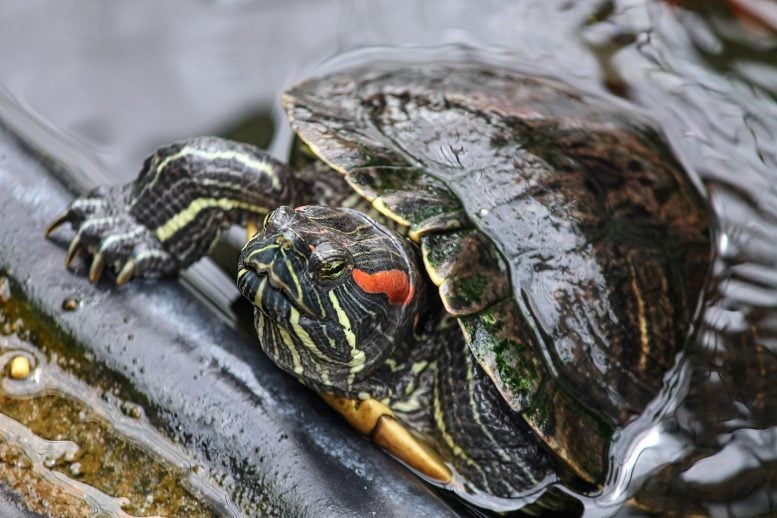
In the summer of 2011, visitors to the University of California, Davis, Arboretum may have witnessed an unusual site: small teams of students wielding large nets, leaping into the arboretum’s waterway to snag basking turtles.
The students weren’t in search of new pets — quite the opposite, in fact. The teams were part of a massive project to remove hundreds of invasive red-eared slider turtles from the arboretum in an effort to observe how California’s native western pond turtles fare in the absence of competitors.
Red-eared sliders are the most commonly traded pet turtles in the world, but are often released into the wild by disgruntled owners when they get too big to handle. Thanks to illegal dumping, the sliders, which are native to the Central United States and Northeastern Mexico, can now be found all over the world. Their new stomping grounds include California, where they vie for food and sunny basking sites with western pond turtles, whose populations are in rapid decline due to agriculture and urbanization.
The results of the removal study, published recently in the journal PeerJ, showed that western pond turtles get a lot fatter and healthier without competition from their invasive brethren — and the remaining sliders likely fare better, too. The study is the first to quantify competition between these two species in the wild.
“I think, finally, we have some good evidence in the United States that it’s time to critically think about not having pet slider turtles, and likely other aquatic turtles, and mitigating this pet trade because it’s not great for the pets, and it’s not great for these wild species either,” said Max Lambert, a postdoctoral researcher at the University of California, Berkeley, and lead author of the study.
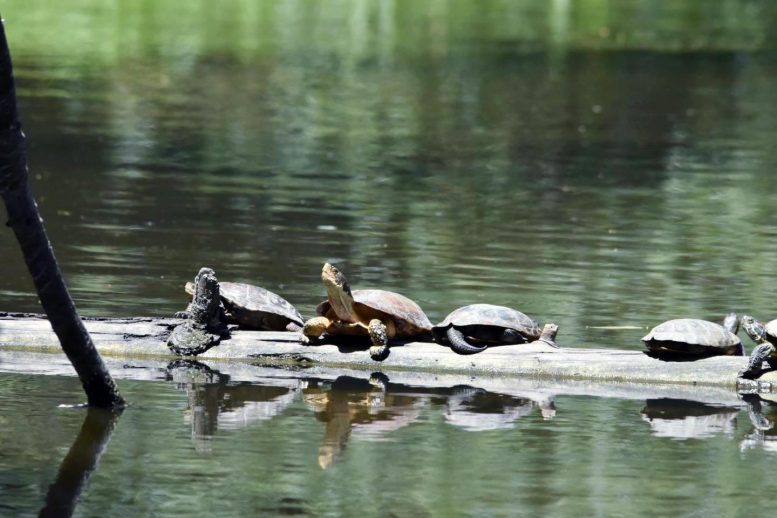
Turtles bask in the sun at Jewel Lake in Northern California’s Tilden Regional Park. In the middle, a western pond turtle, one of California’s few native turtles, holds up it’s head, and on the far right sits an invasive red-eared slider turtle, which can be identified by the characteristic red stripe on the side of its head. Credit: Robin Lopez
It’s not hard to see why red-eared sliders are the most popular pet turtle in the United States: As hatchlings, sliders are small, friendly, and sport striking red stripes on either side of their heads.
But give it a few years, and the once-cute reptiles grow snappy, smelly, and can expand to the size of a dinner plate.
“They are so cheap, they are in every single pet store, and they seem like a great pet until they get to be a few years old, and then they get big, mean, smelly, and are a pain to take care of,” Lambert said. “So, people just take them to a nearby pond and let them go.”
As an undergraduate studying ecology and conservation at UC Davis, Lambert was curious to know what effect these invasive turtles might be having on western pond turtles, which are currently listed as vulnerable on IUCN’s Red List of Threatened Species. While experiments in laboratory settings have hinted that sliders will compete for food with pond turtles, he couldn’t find any data looking at how the two species interact in the wild.
Lambert and five other UC Davis undergraduates teamed up with their faculty adviser, H. Bradley Shaffer, who is a professor of ecology and evolutionary biology at UCLA, and Gregory Pauly, curator of herpetology at the Natural History Museum of Los Angeles County and senior author of the study, to design the removal experiment.
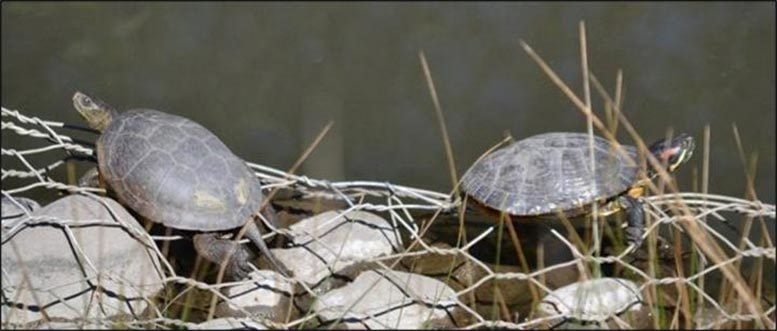
A western pond turtle (left) and a red-eared slider (right) sit side by side in the UC Davis Arboretum. Credit: Max Lambert
With the help of volunteers and other UC Davis undergraduates, including Jennifer McKenzie and Robyn Screen, who are co-first authors of the recent publication, the team used turtle traps, nets, and, when necessary, their own hands, to remove and euthanize 177 red-eared sliders living in the UC Davis Arboretum waterway during the summer of 2011. Lambert estimates they caught about 90 percent of the total red-eared slider population in the arboretum.
They also tracked the weight of the western pond turtles and observed the turtles’ basking habits. Time spent basking in the sun is critical for cold-blooded turtles; they need the heat to power digestion and their immune systems, Lambert said.
The researchers found that, in the year after the slider removal, the pond turtles gained an average of about 40 grams, representing about 5 to 10% of their body weight — quite a lot for a turtle. This weight gain is especially important for female turtles, whose egg clutch size is related to their overall size, Pauly said.
“If these females are much healthier and much more likely to have larger clutch sizes, that increases the likelihood that we are then going to get more juvenile turtles cruising around these urban waterways,” said Pauly, who was a postdoctoral researcher studying reptile and amphibian conservation at UC Davis at the start of the experiment.
While the slider removal didn’t have much of an impact on the western pond turtles’ basking behavior, the researchers did find that the remaining sliders spread out to a few select basking sites, indicating that they were actually crowding each other out before the removal.
“The reality is, in many of these urban ponds, there are so many red-eared sliders that there are high levels of competition amongst those sliders for basking sites and also probably for food,” Pauly said. “It’s not just that red-eared sliders are having negative impacts on the western pond turtles, but the red-eared sliders are themselves facing this huge series of challenges.”
As a postdoctoral researcher at UC Berkeley, Lambert says he has plans to study western pond turtles and red-eared sliders in the Bay Area. He is initiating partnerships with the East Bay Regional Park District to first observe western pond turtles in ponds and lakes in the system, and then conduct another intensive removal of red-eared sliders in and around places like Jewel Lake.
“What we found with our slider removal at Davis was that it was just so human-intensive and would cost any agency a ton of money to do what we did at that scale,” Lambert said. “And so, while it seems that slider removal has an effect, the question is, ‘How much of an effect is it having, relative to western pond turtles living in an urban place, where they get run over by cars, eaten by raccoons and coyotes and dogs and sometimes taken home as pets by people not realizing the negative impacts they are having?’ We’re hoping to parse out a bit better the degree to which sliders are having an impact relative to every other challenge we throw at these turtles.”
Reference: “Experimental removal of introduced slider turtles offers new insight into competition with a native, threatened turtle” by Max R. Lambert , Jennifer M. McKenzie, Robyn M. Screen, Adam G. Clause, Benjamin B. Johnson, Genevieve G. Mount, H Bradley Shaffer and Gregory B. Pauly, 15 August 2019, PeerJ.
DOI: 10.7717/peerj.7444
Co-authors of the paper include Jennifer M. McKenzie of the University of Kentucky, Robyn M. Screen of the University of Hawaii at Manoa, Adam G. Clause of the Natural History Museum of Los Angeles County, Benjamin B. Johnson of Cornell University and Genevieve G. Mount of Louisiana State University.
This work was supported by National Science Foundation DEB grants (1257648 & 1457832), the Natural History Museum of Los Angeles County and the Northern California Herpetological Society.


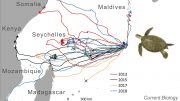



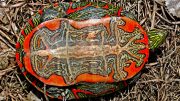

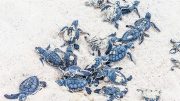
Relatedly, California annually imports some 300,000-to-400,000 freshwater turtles for human consumption, mostly red-eared sliders and softshells. Plus an estimated two million American bullfrogs. NONE of these animals are native to California, and they are routinely released into local waters, where they prey upon and displace the natives, while spreading all sorts of diseases and parasites.
Worse, numerous necropsies since the mid-1990’s have documented that ALL the market frogs and turtles are diseased and/or parasitized, though it is ILLEGAL to sell such products. Law enforcement is practically nil. Worse still, the majority of the bullfrogs test positive for the chytrid fungus (Bd), which has caused the extinctions of 200+ amphibian species worldwide in recent years. The bullfrogs generally do not succumb to the fungus, but they certainly do disperse it.
PARTIAL FIX: The Dept. of Fish & Wildlife (DFW) needs to cease issuing the import permits for these animals. They pose huge risks for the environment, public health and animal welfare. Tour the Chinatown markets, if in doubt.
WRITE: Chuck Bonham, director, DFW, Resources Building, 1416 Ninth Street, Sacramento, CA 95814; email – [email protected]; Resources Secretary Wade Crowfoot, same address, email – [email protected]; Fish & Game Commission, same address, email – fgc.ca.gov
The State Fish & Game Commission has twice voted unanimously to stop the import permits, but were ignored by the Department.
Legislation is long overdue to stop this destructive commerce. All legislators may be written c/o The State Capitol, Sacramento, CA 95814.
Kudos to all the people involved in the removal of the invasive RES and repopulating with our native Western Pond Turtles. As a native Californian, a prior DFG (CDFW) game warden for 27 years and a environmental consultant since retiring I have personally observed the replacement of WPT by the RES. The pet trade has contributed to some of the RES being placed in the wild but most of those are small and struggle to survive. However the introduction of millions of live imported MATURE RES which have a better chance for survival has had a bigger negative impact. Importation permits were issued in the 1990’s by DFG (CDFW) against the wishes of the field wardens and biologists. Market turtles are purchased and released by religious groups and animal lovers believing they are helping the animals. There are laws to prevent this but easily circumvented if you have the right connections. Market turtles have been independently tested and carry many diseases which get transmitted to our natives in the wild. Bottom line: Its great to be putting the WPT back into its native habitat but they will just get pushed out again when the study supply of RES are reintroduced. The importation permits can be revoked with the stroke of a pen just as they were granted years ago. There are also regulations no in place that if enforced would stop the importations. CDFW has to make a choice – Deliver its mandate and protect the environment or give in to special interest groups.